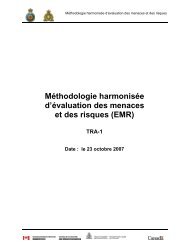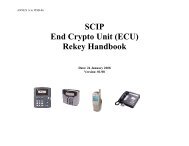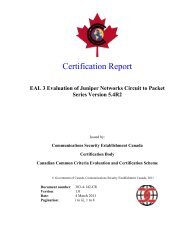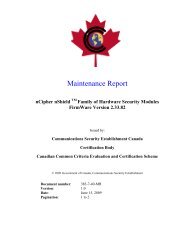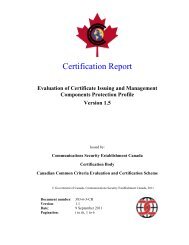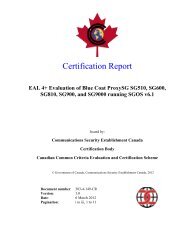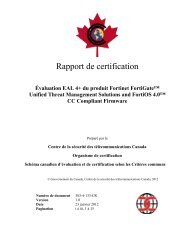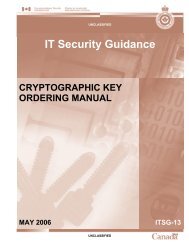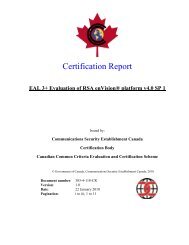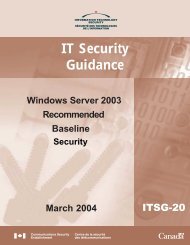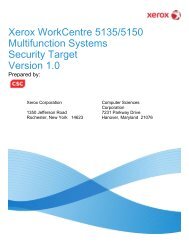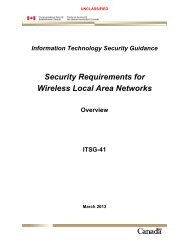Conseils sur l'utilisation du protocole TLS - Centre de la sécurité des ...
Conseils sur l'utilisation du protocole TLS - Centre de la sécurité des ...
Conseils sur l'utilisation du protocole TLS - Centre de la sécurité des ...
Create successful ePaper yourself
Turn your PDF publications into a flip-book with our unique Google optimized e-Paper software.
IT Security Bulletin<br />
Bulletin <strong>de</strong> sécurité TI<br />
November 2008 ITSB-60 novembre 2008<br />
Guidance on the Use of the<br />
Transport Layer Security Protocol<br />
within the Government of Canada<br />
Purpose<br />
The purpose of this Bulletin is to provi<strong>de</strong><br />
Government of Canada (GC) <strong>de</strong>partments<br />
guidance on:<br />
- using the Transport Layer Security (<strong>TLS</strong>)<br />
protocol for the protection of Protected A<br />
and B information;<br />
- the approved cryptographic protocols and<br />
algorithms that the Communications<br />
Security Establishment Canada (CSEC)<br />
recommends for use with <strong>TLS</strong>; and<br />
- standards and NIST special publications that<br />
<strong>de</strong>scribe the recommen<strong>de</strong>d cryptographic<br />
primitives and provi<strong>de</strong> additional<br />
information on <strong>TLS</strong>.<br />
This Bulletin is to be used in conjunction<br />
with CSEC IT Security Alert 11d (ITSA-<br />
11d), published on August 2008.<br />
<strong>Conseils</strong> <strong>sur</strong> l’utilisation <strong>du</strong> <strong>protocole</strong><br />
<strong>TLS</strong> (Transport Layer Security) au sein<br />
<strong>du</strong> gouvernement <strong>du</strong> Canada<br />
Objet<br />
Le présent bulletin vise à fournir aux ministères <strong>du</strong><br />
gouvernement <strong>du</strong> Canada (GC) <strong>de</strong>s conseils <strong>sur</strong> :<br />
- l’utilisation <strong>du</strong> <strong>protocole</strong> <strong>de</strong> sécurité <strong>de</strong> <strong>la</strong> couche<br />
transport (<strong>TLS</strong> pour Transport Layer Security)<br />
pour <strong>la</strong> protection <strong>de</strong>s renseignements PROTÉGÉ<br />
A et PROTÉGÉ B;<br />
- les <strong>protocole</strong>s et algorithmes cryptographiques<br />
approuvés que le <strong>Centre</strong> <strong>de</strong> <strong>la</strong> sécurité <strong>de</strong>s<br />
télécommunications (CSTC) recomman<strong>de</strong><br />
d’utiliser conjointement avec le <strong>protocole</strong> <strong>TLS</strong>;<br />
- les normes et publications spéciales <strong>du</strong> NIST qui<br />
décrivent les primitives cryptographiques<br />
recommandées et fournissent <strong>de</strong>s renseignements<br />
additionnels <strong>sur</strong> le <strong>protocole</strong> <strong>TLS</strong>.<br />
Le présent bulletin doit être utilisé en conjonction<br />
avec l’Alerte <strong>de</strong> sécurité TI 11d (ITSA-11d) <strong>du</strong><br />
CSTC, publiée en août 2008.<br />
1
November 2008 ITSB-60 novembre 2008<br />
Scope<br />
This Bulletin provi<strong>de</strong>s guidance on using an<br />
implementation of the <strong>TLS</strong> protocol that<br />
conforms to standards by the Internet<br />
Engineering Task Force (IETF) in RFC 2246 or<br />
RFC 4346. Technical <strong>de</strong>tails of how to<br />
implement <strong>TLS</strong> can be found in those<br />
standards.<br />
Guidance provi<strong>de</strong>d in this Bulletin is relevant<br />
only for the protection of Protected A and B<br />
information. The protection of Protected C and<br />
c<strong>la</strong>ssified information is beyond the scope of<br />
this Bulletin.<br />
This Bulletin does not provi<strong>de</strong> guidance on the<br />
implementation of cryptographic algorithms,<br />
key exchange protocols, hash functions, or<br />
random bit generation. References for<br />
cryptographic primitives are highlighted in the<br />
References section.<br />
Background<br />
<strong>TLS</strong> is a cryptographic protocol that provi<strong>de</strong>s<br />
secure communications by securing the<br />
transport <strong>la</strong>yer of the Open System<br />
Interconnection Basic Reference Mo<strong>de</strong>l (OSI<br />
Mo<strong>de</strong>l). The transport <strong>la</strong>yer is responsible for<br />
maintaining reliable end-to-end<br />
communications across the network. For<br />
authentication, <strong>TLS</strong> is mostly used for server<br />
authentication but can additionally be used for<br />
client authentication.<br />
<strong>TLS</strong> was initially called the Secure Socket<br />
Layer (SSL) protocol but was slightly modified<br />
and renamed the <strong>TLS</strong> protocol when<br />
standardized by the IETF.<br />
The <strong>TLS</strong> standard inclu<strong>de</strong>s many cryptographic<br />
protocols and algorithms that are not approved<br />
for the protection of Protected A and B<br />
Portée<br />
Le présent bulletin fournit <strong>de</strong>s conseils <strong>sur</strong> l’utilisation<br />
d’une mise en oeuvre <strong>du</strong> <strong>protocole</strong> <strong>TLS</strong> qui est<br />
conforme aux normes établies par l’Internet<br />
Engineering Task Force (IETF) dans les documents<br />
RFC 2246 ou RFC 4346. On peut retrouver dans ces<br />
normes les détails techniques <strong>sur</strong> <strong>la</strong> mise en oeuvre <strong>du</strong><br />
<strong>protocole</strong> <strong>TLS</strong>.<br />
Les conseils formulés ci-après concernent uniquement<br />
<strong>la</strong> protection <strong>de</strong>s renseignements PROTÉGÉ A et<br />
PROTÉGÉ B; <strong>la</strong> protection <strong>de</strong>s renseignements<br />
PROTÉGÉ C et c<strong>la</strong>ssifiés dépassent les limites <strong>du</strong><br />
présent bulletin.<br />
Le présent bulletin n’offre aucune orientation quant à<br />
<strong>la</strong> mise en oeuvre <strong>de</strong>s algorithmes cryptographiques,<br />
<strong>de</strong>s <strong>protocole</strong>s d’échange <strong>de</strong> clés, <strong>de</strong>s fonctions <strong>de</strong><br />
hachage et <strong>de</strong> <strong>la</strong> génération <strong>de</strong> bits aléatoires. Les<br />
références pour les primitives cryptographiques sont<br />
indiquées dans <strong>la</strong> section Références.<br />
Contexte<br />
Le <strong>protocole</strong> <strong>TLS</strong> est un <strong>protocole</strong> cryptographique<br />
qui offre <strong>de</strong>s communications sécurisées en sécurisant<br />
<strong>la</strong> couche transport <strong>du</strong> Open System Interconnection<br />
Basic Reference Mo<strong>de</strong>l (OSI Mo<strong>de</strong>l). Cette couche est<br />
responsable <strong>du</strong> maintien <strong>de</strong> communications <strong>de</strong> bout<br />
en bout fiables dans le réseau. Le <strong>protocole</strong> <strong>TLS</strong> sert<br />
principalement à l’authentification serveur mais peut<br />
également être utilisé pour l’authentification client.<br />
Le <strong>protocole</strong> <strong>TLS</strong> était appelé à l’origine « <strong>protocole</strong><br />
Secure Socket Layer (SSL) », mais il a été légèrement<br />
modifié et renommé « <strong>protocole</strong> <strong>TLS</strong> » lorsqu’il a été<br />
normalisé par l’IETF.<br />
La norme <strong>TLS</strong> comprend <strong>de</strong> nombreux <strong>protocole</strong>s et<br />
algorithmes cryptographiques qui ne sont pas<br />
approuvés pour <strong>la</strong> protection <strong>de</strong>s renseignements<br />
PROTÉGÉ A et PROTÉGÉ B. Par ailleurs, certains<br />
<strong>protocole</strong>s et algorithmes cryptographiques qui ne<br />
2
November 2008 ITSB-60 novembre 2008<br />
information. Furthermore, some cryptographic<br />
protocols and algorithms not listed in the <strong>TLS</strong><br />
standard are approved. Table 1 in the<br />
Recommendation section explicitly specifies<br />
which cryptographic primitives CSEC approves<br />
for the safeguard of Protected A and B<br />
information.<br />
Overview of the Transport Layer<br />
Security<br />
An entity using <strong>TLS</strong> has a cipher suite which is<br />
a list of key establishment protocols,<br />
encryption algorithms, digital signatures, and<br />
hash functions avai<strong>la</strong>ble for use as well as the<br />
cryptographic parameters such as key size.<br />
<strong>TLS</strong> secures the transport <strong>la</strong>yer in two phases:<br />
the <strong>TLS</strong> handshake and the <strong>TLS</strong> record<br />
protocol. All cryptographic configurations are<br />
done in the handshake phase.<br />
In the handshake phase, the client contacts the<br />
server with a list of supported ciphers and a<br />
random value. The server responds by choosing<br />
a cipher from the cipher suite as well as<br />
sending a random value and a certificate. The<br />
client authenticates the server through the<br />
certificate and either accepts the proposed<br />
cipher and cryptographic parameters or repeats<br />
the negotiation step until both parties are in<br />
agreement. The client encrypts a premaster<br />
secret and sends it to the server. Both parties<br />
can then compute shared common keys from<br />
the premaster secret and the exchanged random<br />
values. Finally both client and server compute a<br />
Message Authentication Co<strong>de</strong> (MAC) of all<br />
handshake messages to en<strong>sur</strong>e that no<br />
tampering of messages has occurred.<br />
An extra pass can optionally be ad<strong>de</strong>d to the<br />
handshake phase where the client sends a<br />
certificate to the server. This allows for client<br />
authentication.<br />
figurent pas dans <strong>la</strong> norme <strong>TLS</strong> sont approuvés. Le<br />
tableau 1 <strong>de</strong> <strong>la</strong> section Recommandations précise les<br />
primitives cryptographiques approuvées par le CSTC<br />
pour <strong>la</strong> protection <strong>de</strong>s renseignements PROTÉGÉ A et<br />
PROTÉGÉ B.<br />
Aperçu <strong>de</strong> <strong>la</strong> sécurité <strong>de</strong> <strong>la</strong> couche transport<br />
(<strong>TLS</strong>)<br />
Une entité utilisant le <strong>protocole</strong> <strong>TLS</strong> a une suite <strong>de</strong><br />
chiffres qui consiste en une liste <strong>de</strong> <strong>protocole</strong>s<br />
d’établissement <strong>de</strong> clés, d’algorithmes <strong>de</strong> chiffrement,<br />
<strong>de</strong> signatures numériques et <strong>de</strong> fonctions <strong>de</strong> hachage<br />
prêts à utiliser, <strong>de</strong> même qu’en paramètres<br />
cryptographiques, telle <strong>la</strong> taille <strong>de</strong>s clés.<br />
Le <strong>protocole</strong> <strong>TLS</strong> sécurise <strong>la</strong> couche transport en <strong>de</strong>ux<br />
phases : <strong>la</strong> phase d’établissement <strong>de</strong> liaison ou<br />
poignée <strong>de</strong> main <strong>TLS</strong> (<strong>TLS</strong> handshake) et <strong>la</strong> phase <strong>de</strong><br />
<strong>protocole</strong> d’enregistrement <strong>TLS</strong> (<strong>TLS</strong> record<br />
protocol). Toutes les configurations cryptographiques<br />
sont effectuées au moment <strong>de</strong> l’établissement <strong>de</strong><br />
liaison.<br />
Dans <strong>la</strong> phase d’établissement <strong>de</strong> liaison, le client<br />
communique avec le serveur et lui fournit une liste <strong>de</strong><br />
chiffres pris en charge et une valeur aléatoire. Le<br />
serveur répond en choisissant un chiffre <strong>de</strong> <strong>la</strong> suite, et<br />
en envoyant une valeur aléatoire et un certificat. Le<br />
client authentifie le serveur au moyen <strong>du</strong> certificat et<br />
accepte le chiffre et les paramètres cryptographiques<br />
proposés ou répète l’étape <strong>de</strong> négociation jusqu’à ce<br />
que les <strong>de</strong>ux parties s’enten<strong>de</strong>nt. Le client chiffre un<br />
secret initial et l’envoie au serveur. Les <strong>de</strong>ux parties<br />
peuvent ensuite calculer les clés communes partagées<br />
à partir <strong>du</strong> secret initial et <strong>de</strong>s valeurs aléatoires<br />
échangées. Enfin, le client et le serveur calculent un<br />
co<strong>de</strong> d’authentification <strong>de</strong> message (MAC pour<br />
Message Authentication Co<strong>de</strong>) <strong>de</strong> tous les messages<br />
d’établissement <strong>de</strong> liaison afin d’as<strong>sur</strong>er qu’aucune<br />
altération <strong>de</strong>s messages ne se pro<strong>du</strong>ise.<br />
Un autre passage machine peut être ajouté à <strong>la</strong> phase<br />
3
November 2008 ITSB-60 novembre 2008<br />
The <strong>TLS</strong> standard does not mandate that the<br />
strongest avai<strong>la</strong>ble ciphers from the cipher suite<br />
or the strongest cryptographic parameters be<br />
used.<br />
The <strong>TLS</strong> record protocol phase breaks the<br />
message to be transmitted into fragments,<br />
optionally compresses the data, applies a MAC<br />
to the data to en<strong>sur</strong>e that the data is not<br />
tampered with, encrypts the data, and then<br />
transmits the data to the recipient. The recipient<br />
then <strong>de</strong>crypts the data, verifies the MAC,<br />
optionally <strong>de</strong>compresses, and reassembles the<br />
fragments to obtain the message.<br />
Recommendation<br />
Departments are strongly advised to adhere to<br />
the following CSEC security baselines when<br />
using <strong>TLS</strong> to protect Protected A and B<br />
information.<br />
CSEC does not approve the use of the SSL 3.0<br />
protocol. Any <strong>TLS</strong> client that supports SSL 3.0<br />
shall disable its use. While <strong>TLS</strong> 1.0 is approved<br />
by CSEC, the use of <strong>TLS</strong> 1.1 or higher is<br />
preferred. <strong>TLS</strong> 1.2 is currently in draft form<br />
and is going through the IETF standardization<br />
process.<br />
Only <strong>TLS</strong> clients that contain cryptographic<br />
mo<strong>du</strong>les that have been validated to Fe<strong>de</strong>ral<br />
Information Processing Standard (FIPS) 140-2<br />
un<strong>de</strong>r the Cryptographic Mo<strong>du</strong>le Validation<br />
Program (CMVP) shall be used. If the <strong>TLS</strong><br />
client also contains cryptographic algorithm<br />
implementations that are not validated un<strong>de</strong>r<br />
the Cryptographic Algorithm Validation<br />
Program (CAVP), the client shall be configured<br />
so that those implementations are not used.<br />
<strong>TLS</strong> clients being used for the protection of<br />
Protected A and B information shall<br />
d’établissement <strong>de</strong> liaison où le client envoie un<br />
certificat au serveur. Ce<strong>la</strong> permet alors d’authentifier<br />
le client.<br />
La norme <strong>TLS</strong> n’exige pas l’utilisation <strong>du</strong> chiffre le<br />
plus robuste <strong>de</strong> <strong>la</strong> suite ni <strong>de</strong>s paramètres<br />
cryptographiques les plus robustes.<br />
La phase <strong>du</strong> <strong>protocole</strong> d’enregistrement <strong>TLS</strong> divise le<br />
message à transmettre en fragments, comprime les<br />
données (en option), applique un MAC aux données<br />
afin <strong>de</strong> s’as<strong>sur</strong>er qu’elles ne sont pas altérées, les<br />
chiffre, puis les transmet au <strong>de</strong>stinataire. Le<br />
<strong>de</strong>stinataire déchiffre ensuite les données, vérifie le<br />
MAC, décomprime les fragments (en option) et les<br />
rassemble pour reconstituer le message.<br />
Recommandation<br />
Le CSTC recomman<strong>de</strong> fortement aux ministères <strong>de</strong><br />
prendre les me<strong>sur</strong>es <strong>de</strong> base suivantes en matière <strong>de</strong><br />
sécurité au moment d’utiliser le <strong>protocole</strong> <strong>TLS</strong> pour<br />
protéger les renseignements PROTÉGÉ A et<br />
PROTÉGÉ B.<br />
Le CSTC n’approuve pas l’utilisation <strong>du</strong> <strong>protocole</strong><br />
SSL 3.0. Tout client <strong>TLS</strong> qui prend en charge ce<br />
<strong>protocole</strong> doit le désactiver. Quoique le CSTC<br />
approuve l’utilisation <strong>du</strong> <strong>protocole</strong> <strong>TLS</strong> 1.0, il<br />
recomman<strong>de</strong> <strong>la</strong> version 1.1 ou une version supérieure.<br />
Le <strong>protocole</strong> <strong>TLS</strong> 1.2 a été soumis au processus <strong>de</strong><br />
normalisation <strong>de</strong> l’IETF et n’est disponible à l’heure<br />
actuelle qu’à l’état d’ébauche.<br />
Seuls les clients <strong>TLS</strong> qui contiennent <strong>de</strong>s mo<strong>du</strong>les<br />
cryptographiques validés au niveau <strong>de</strong> <strong>la</strong> Fe<strong>de</strong>ral<br />
Information Processing Standard (FIPS) 140-2 en<br />
vertu <strong>du</strong> Programme <strong>de</strong> validation <strong>de</strong>s mo<strong>du</strong>les<br />
cryptographiques (PVMC) doivent être utilisés. Si le<br />
client <strong>TLS</strong> contient également <strong>de</strong>s mises en oeuvre<br />
cryptographiques qui n’ont pas été validées en vertu<br />
<strong>du</strong> Cryptographic Algorithm Validation Program<br />
(CAVP), il faudra le configurer <strong>de</strong> sorte qu’il n’utilise<br />
pas ces mises en oeuvre.<br />
4
November 2008 ITSB-60 novembre 2008<br />
authenticate both the client and the server.<br />
A <strong>TLS</strong> session shall not <strong>la</strong>st longer than<br />
24 hours. After 24 hours, the session shall be<br />
terminated and a new key exchange shall be<br />
initiated to open a new session.<br />
Table 1 lists the approved cryptographic<br />
primitives that shall be used for the protection<br />
of Protected A and B information. Table 1 is to<br />
be used in conjunction with ITSA-11d, which<br />
states that SKIPJACK, KEA, and 80-bit<br />
CAST5 shall be discontinued by the end of<br />
2010 for the protection of Protected A and<br />
Protected B information.<br />
When using Diffie-Hellman or Elliptic Curve<br />
Diffie-Hellman for key exchange, only the<br />
ephemeral Diffie-Hellman key exchange shall<br />
be used. Fixed Diffie-Hellman and anonymous<br />
Diffie-Hellman shall not be employed.<br />
Furthermore, it should be noted that Menezes-<br />
Qu-Vanstone (MQV) is a patented protocol.<br />
Approved elliptic curve parameters are<br />
specified in ITSA-11d. Recommen<strong>de</strong>d curves<br />
can be found in Appendix 6 of FIPS 186-2.<br />
Integrity protection algorithms through a Hashbased<br />
Message Authentication Co<strong>de</strong> (HMAC)<br />
or Cipher-based Message Authentication Co<strong>de</strong><br />
(CMAC) are specified in ITSA-11d.<br />
Approved mo<strong>de</strong>s of operations for block<br />
ciphers as well as padding schemes for key<br />
establishment and digital signatures, and key<br />
sizes are specified in ITSA-11d.<br />
The use of random bit generators evaluated by<br />
the CMVP is strongly recommen<strong>de</strong>d. Approved<br />
random bit generators are specified in ITSA-<br />
11d.<br />
The <strong>TLS</strong> standard incorporates the following<br />
Les clients <strong>TLS</strong> utilisés pour <strong>la</strong> protection <strong>de</strong><br />
renseignements PROTÉGÉ A et PROTÉGÉ B doivent<br />
authentifier le client et le serveur.<br />
Une session <strong>TLS</strong> ne doit pas <strong>du</strong>rer plus <strong>de</strong> 24 heures.<br />
Après 24 heures, <strong>la</strong> session doit être interrompue et un<br />
nouvel échange <strong>de</strong> clés doit être <strong>la</strong>ncé pour ouvrir une<br />
nouvelle session.<br />
Le tableau 1 comprend <strong>la</strong> liste <strong>de</strong>s primitives<br />
cryptographiques approuvées qui doivent être utilisées<br />
pour <strong>la</strong> protection <strong>de</strong>s renseignements PROTÉGÉ A et<br />
PROTÉGÉ B. Le tableau 1 doit être consulté<br />
conjointement avec l’ITSA-11d, qui énonce que<br />
SKIPJACK, KEA, et CAST5 (80 bits) doivent être<br />
discontinués d’ici <strong>la</strong> fin <strong>de</strong> 2010 re<strong>la</strong>tivement à <strong>la</strong><br />
protection <strong>de</strong>s renseignements PROTÉGÉ A et<br />
PROTÉGÉ B.<br />
Lorsque le <strong>protocole</strong> Diffie-Hellman ou<br />
Diffie-Hellman à courbe elliptique est utilisé pour<br />
l’échange <strong>de</strong> clés, seul l’échange <strong>de</strong> clés Diffie-<br />
Hellman éphémère doit être utilisé. Les <strong>protocole</strong>s<br />
Diffie-Hellman fixes et anonymes ne doivent pas<br />
l’être. De plus, il est à noter que le <strong>protocole</strong><br />
Menezes-Qu-Vanstone (MQV) est breveté.<br />
Les paramètres <strong>de</strong> courbe elliptique approuvés sont<br />
précisés dans l’ITSA-11d. Les courbes recommandées<br />
sont données à l’appendice 6 <strong>de</strong> <strong>la</strong> FIPS 186-2.<br />
Les algorithmes <strong>de</strong> protection <strong>de</strong> l’intégrité par MAC<br />
à base <strong>de</strong> fonction <strong>de</strong> hachage (HMAC) ou <strong>de</strong> MAC à<br />
base <strong>de</strong> fonction <strong>de</strong> chiffrement (CMAC) sont précisés<br />
dans l’ITSA-11d.<br />
Les mo<strong>de</strong>s d’exploitation approuvés pour les<br />
algorithmes <strong>de</strong> chiffrement par bloc et les <strong>protocole</strong>s<br />
<strong>de</strong> remplissage pour l’établissement <strong>de</strong>s clés et les<br />
signatures numériques, <strong>de</strong> même que les tailles <strong>de</strong>s<br />
clés, sont précisés dans l’ITSA-11d.<br />
L’utilisation <strong>de</strong> générateurs <strong>de</strong> bits aléatoires évalués<br />
par le PVMC est fortement recommandée. Les<br />
5
November 2008 ITSB-60 novembre 2008<br />
cryptographic primitives in the cipher suite<br />
which shall not be used for the protection of<br />
Protected A and B information: Kerberos, RC2,<br />
RC4, IDEA, DES, Camellia, MD2, MD4, and<br />
MD5. CSEC recommends that any <strong>TLS</strong> client<br />
that supports these protocols and algorithms be<br />
disabled.<br />
The NULL parameter shall not be used for any<br />
cryptographic primitive.<br />
générateurs <strong>de</strong> bits aléatoires approuvés sont précisés<br />
dans l’ITSA-11d.<br />
La norme <strong>TLS</strong> incorpore les primitives<br />
cryptographiques suivantes dans <strong>la</strong> suite <strong>de</strong> chiffres<br />
qui ne doivent pas être utilisées pour <strong>la</strong> protection <strong>de</strong>s<br />
renseignements PROTÉGÉ A et PROTÉGÉ B :<br />
Kerberos, RC2, RC4, IDEA, DES, Camellia, MD2,<br />
MD4 et MD5. Le CSTC recomman<strong>de</strong> <strong>de</strong> désactiver<br />
tout client <strong>TLS</strong> qui peut prendre en charge ces<br />
algorithmes et <strong>protocole</strong>s.<br />
Le paramètre NULL ne doit être utilisé pour aucune<br />
primitive cryptographique.<br />
Table 1 : Approved Cryptographic Primitives for <strong>TLS</strong>/<br />
Tableau 1 : Primitives cryptographiques approuvées pour le <strong>protocole</strong> <strong>TLS</strong><br />
Key<br />
Establishment/<br />
Établissement<br />
<strong>de</strong> clés<br />
RSA<br />
Block<br />
Ciphers/<br />
Chiffrement<br />
par bloc<br />
AES<br />
Hash<br />
Functions/<br />
Fonctions<br />
<strong>de</strong> hachage<br />
SHA-1<br />
Digital<br />
Signatures/<br />
Signatures<br />
numériques<br />
DSA<br />
Random Bit Generation/<br />
Génération <strong>de</strong> bits<br />
aléatoires<br />
Hash_DRBG<br />
Integrity<br />
Protection/<br />
Protection<br />
<strong>de</strong> l’intégrité<br />
HMAC<br />
Diffie-Hellman<br />
Triple DES<br />
SHA-224<br />
RSA<br />
HMAC_DRBG<br />
CMAC<br />
Key Exchange<br />
Algorithm (KEA)<br />
Elliptic Curve<br />
Diffie-Hellman<br />
Elliptic Curve<br />
MQV<br />
CAST5<br />
SKIPJACK<br />
SHA-256<br />
SHA-384<br />
SHA-512<br />
Elliptic Curve<br />
DSA<br />
CTR_DRBG<br />
Dual_EC_DRBG<br />
Legacy DRBGs based on DES,<br />
Triple DES, AES, SHA-1, and<br />
HMAC /<br />
Anciens générateurs <strong>de</strong> bits<br />
aléatoires déterministes fondés<br />
<strong>sur</strong> DES, Triple DES, AES,<br />
SHA-1, et HMAC.<br />
References<br />
There are numerous standards and NIST<br />
Special Publications which <strong>de</strong>fine the<br />
cryptographic primitives used in this Bulletin<br />
as well as documents to provi<strong>de</strong> guidance on<br />
security parameters.<br />
Références<br />
Il existe <strong>de</strong> nombreuses normes et publications<br />
spéciales <strong>du</strong> NIST qui définissent officiellement les<br />
primitives cryptographiques utilisées dans le présent<br />
bulletin, <strong>de</strong> même que <strong>de</strong>s documents offrant <strong>de</strong>s<br />
conseils <strong>sur</strong> les paramètres <strong>de</strong> sécurité.<br />
6
November 2008 ITSB-60 novembre 2008<br />
If there are any discrepancies between this<br />
guidance and the following references, then the<br />
guidance for security parameters in this<br />
Bulletin and in ITSA-11d shall be followed.<br />
IT Security Alert 11d<br />
CSEC Approved Cryptographic<br />
Algorithms for the Protection of<br />
Protected Information and for Electronic<br />
Authentication and Authorization<br />
Applications within the Government of<br />
Canada (ITSA-11d)<br />
The ITSA-11d provi<strong>de</strong>s guidance on<br />
approved protocols and algorithms for<br />
encryption, key establishment, digital<br />
signatures, hashing, data integrity, and<br />
padding schemes.<br />
http://www.csecst.gc.ca/documents/publications/govpubs/itsa/itsa11d-e.pdf<br />
Transport Layer Security (<strong>TLS</strong>)<br />
IETF RFC 4346<br />
Version 1.1 of the <strong>TLS</strong> protocol.<br />
http://www.ietf.org/rfc/rfc4346.txt<br />
IETF RFC 2246<br />
Version 1.0 of the <strong>TLS</strong> protocol.<br />
http://www.ietf.org/rfc/rfc2246.txt<br />
NIST Special Publication 800-52<br />
This publication provi<strong>de</strong>s gui<strong>de</strong>lines and<br />
recommendations on security parameters for<br />
<strong>TLS</strong>.<br />
http://csrc.nist.gov/publications/nistpubs/800<br />
-52/SP800-52.pdf<br />
Elliptic Curves<br />
FIPS 186-2, FIPS 186-3<br />
Appendix 6 of the Digital Signature<br />
Standard gives the parameters for approved<br />
En cas <strong>de</strong> divergence entre ces conseils et les<br />
références qui suivent, il faudra suivre les conseils<br />
liés aux paramètres <strong>de</strong> sécurité donnés dans le<br />
présent bulletin et dans l’ITSA-11d.<br />
Alerte <strong>de</strong> sécurité TI 11d<br />
Algorithmes cryptographiques approuvés par<br />
le CSTC pour <strong>la</strong> protection <strong>de</strong>s renseignements<br />
désignés PROTÉGÉ et pour les applications<br />
d’authentification et d’autorisation<br />
électroniques au sein <strong>du</strong> gouvernement <strong>du</strong><br />
Canada (ITSA-11d)<br />
L’ITSA-11d fournit une orientation <strong>sur</strong> les<br />
<strong>protocole</strong>s et algorithmes approuvés pour le<br />
chiffrement, l’établissement <strong>de</strong>s clés, les<br />
signatures numériques, le hachage, l’intégrité <strong>de</strong>s<br />
données et les <strong>protocole</strong>s <strong>de</strong> remplissage.<br />
http://www.csecst.gc.ca/documents/publications/govpubs/itsa/itsa11d-f.pdf<br />
Protocole <strong>TLS</strong><br />
IETF RFC 4346<br />
Version 1.1 <strong>du</strong> <strong>protocole</strong> <strong>TLS</strong>.<br />
http://www.ietf.org/rfc/rfc4346.txt<br />
IETF RFC 2246<br />
Version 1.0 <strong>du</strong> <strong>protocole</strong> <strong>TLS</strong>.<br />
http://www.ietf.org/rfc/rfc2246.txt<br />
Publication spéciale 800-52 <strong>du</strong> NIST<br />
Cette publication spéciale fournit les directives et<br />
recommandations <strong>sur</strong> les paramètres <strong>de</strong> sécurité<br />
pour le <strong>protocole</strong> <strong>TLS</strong>.<br />
http://csrc.nist.gov/publications/nistpubs/800-<br />
52/SP800-52.pdf<br />
Courbes elliptiques<br />
FIPS 186-2, FIPS 186-3<br />
L’appendice 6 <strong>de</strong> <strong>la</strong> norme Digital Signature<br />
Standard donne les paramètres pour les courbes<br />
7
November 2008 ITSB-60 novembre 2008<br />
elliptic curves as well as provi<strong>de</strong>s guidance<br />
on implementing elliptic curve<br />
cryptography. Note that FIPS 186-3 is<br />
currently a draft.<br />
http://csrc.nist.gov/publications/fips/fips186-<br />
2/fips186-2-change1.pdf<br />
http://csrc.nist.gov/publications/drafts/fips_1<br />
86-3/Draft-FIPS-186-3%20_March2006.pdf<br />
elliptiques approuvées <strong>de</strong> même que <strong>de</strong>s conseils<br />
<strong>sur</strong> <strong>la</strong> mise en oeuvre <strong>de</strong> <strong>la</strong> cryptographie à courbe<br />
elliptique. Il est à noter que <strong>la</strong> FIPS 186-3 est à<br />
l’état d’ébauche.<br />
http://csrc.nist.gov/publications/fips/fips186-<br />
2/fips186-2-change1.pdf<br />
http://csrc.nist.gov/publications/drafts/fips_186-<br />
3/Draft-FIPS-186-3%20_March2006.pdf<br />
Key Management<br />
NIST Special Publication 800-57<br />
This three part publication provi<strong>de</strong>s guidance<br />
on key management.<br />
http://csrc.nist.gov/publications/nistpubs/800<br />
-57/sp800-57-Part1-revised2_Mar08-<br />
2007.pdf<br />
http://csrc.nist.gov/publications/nistpubs/800<br />
-57/SP800-57-Part2.pdf<br />
NIST Special Publication 800-56A<br />
This publication specifies the Diffie-<br />
Hellman and MQV key exchange protocols<br />
using discrete logarithms.<br />
http://csrc.nist.gov/publications/nistpubs/800<br />
-56A/SP800-56A_Revision1_Mar08-<br />
2007.pdf<br />
ANS X9.44<br />
This standard specifies the RSA key<br />
exchange algorithm using integer<br />
factorization.<br />
SKIPJACK and KEA Algorithm<br />
Specifications Version 2.0<br />
This document is the specification for the<br />
Key Exchange Algorithm (KEA).<br />
http://csrc.nist.gov/encryption/skipjack/skipj<br />
ack.pdf<br />
Gestion <strong>de</strong>s clés<br />
Publication spéciale 800-57 <strong>du</strong> NIST<br />
Cette publication spéciale à trois parties fournit<br />
<strong>de</strong>s conseils <strong>sur</strong> <strong>la</strong> gestion <strong>de</strong>s clés.<br />
http://csrc.nist.gov/publications/nistpubs/800-<br />
57/sp800-57-Part1-revised2_Mar08-2007.pdf<br />
http://csrc.nist.gov/publications/nistpubs/800-<br />
57/SP800-57-Part2.pdf<br />
Publication spéciale 800-56A <strong>du</strong> NIST<br />
Cette publication spéciale précise les <strong>protocole</strong>s<br />
d’échange <strong>de</strong> clés Diffie-Hellman et MQV<br />
utilisant <strong>de</strong>s algorithmes discrets.<br />
http://csrc.nist.gov/publications/nistpubs/800-<br />
56A/SP800-56A_Revision1_Mar08-2007.pdf<br />
ANS X9.44<br />
Cette norme précise l’algorithme d’échange <strong>de</strong><br />
clés RSA utilisant <strong>la</strong> factorisation <strong>de</strong>s nombres<br />
entiers.<br />
Spécifications <strong>de</strong>s algorithmes SKIPJACK et<br />
KEA, Version 2.0<br />
Ce document constitue <strong>la</strong> spécification pour<br />
l’algorithme d’échange <strong>de</strong> clés (KEA pour Key<br />
Exchange Algorithm).<br />
http://csrc.nist.gov/encryption/skipjack/skipjack.p<br />
df<br />
8
November 2008 ITSB-60 novembre 2008<br />
Hashing<br />
FIPS 180-3<br />
The Secure Hash Signature Standard<br />
specifies the five approved hashing<br />
algorithms: SHA-1, SHA-224, SHA-256,<br />
SHA-384, and SHA-512.<br />
http://csrc.nist.gov/publications/fips/fips180<br />
-3/fips180-3_final.pdf<br />
Digital Signatures<br />
FIPS 186-2, FIPS 186-3<br />
The Digital Signature Standard provi<strong>de</strong>s<br />
guidance on generating digital signatures.<br />
The standard inclu<strong>de</strong>s the Digital Signature<br />
Algorithm, the RSA digital signature<br />
algorithm, and the Elliptic Curve Digital<br />
Signature Algorithm. These FIPS standards<br />
are used in conjunction with ANS X9.31 for<br />
RSA digital signatures and ANS X9.62 for<br />
elliptic curve digital signatures. Note that<br />
FIPS 186-3 is currently a draft.<br />
http://csrc.nist.gov/publications/fips/fips186-<br />
2/fips186-2-change1.pdf<br />
http://csrc.nist.gov/publications/drafts/fips_1<br />
86-3/Draft-FIPS-186-3%20_March2006.pdf<br />
ANS X9.31<br />
This standard specifies the RSA digital<br />
signature algorithm and padding scheme.<br />
ANS X9.62<br />
This standard specifies the Elliptic Curve<br />
Digital Signature Algorithm (ECDSA).<br />
Block Ciphers<br />
ANS X9.52<br />
This standard specifies the requirements for<br />
Triple DES.<br />
FIPS 197<br />
Hachage<br />
FIPS 180-3<br />
La norme <strong>de</strong> signature <strong>de</strong> hachage sécurisé<br />
précise les cinq algorithmes <strong>de</strong> hachage<br />
approuvés : SHA-1, SHA-224, SHA-256, SHA-<br />
384 et SHA-512.<br />
http://csrc.nist.gov/publications/fips/fips180-<br />
3/fips180-3_final.pdf<br />
Signatures numériques<br />
FIPS 186-2, FIPS 186-3<br />
La norme <strong>sur</strong> <strong>la</strong> signature numérique fournit une<br />
orientation <strong>sur</strong> <strong>la</strong> génération <strong>de</strong> signatures<br />
numériques. La norme comprend l’algorithme <strong>de</strong><br />
signature numérique (DSA pour Digital Signature<br />
Algorithm), l’algorithme <strong>de</strong> signature numérique<br />
RSA et l’algorithme <strong>de</strong> signature numérique à<br />
courbe elliptique. Ces normes FIPS sont utilisées<br />
conjointement avec <strong>la</strong> norme ANS X9.31 pour les<br />
signatures numériques RSA et <strong>la</strong> norme ANS<br />
X9.62 pour les signatures numériques à courbe<br />
elliptique. Il est à noter que <strong>la</strong> FIPS 186-3 est à<br />
l’état d’ébauche.<br />
http://csrc.nist.gov/publications/fips/fips186-<br />
2/fips186-2-change1.pdf<br />
http://csrc.nist.gov/publications/drafts/fips_186-<br />
3/Draft-FIPS-186-3%20_March2006.pdf<br />
ANS X9.31<br />
Cette norme précise le <strong>protocole</strong> <strong>de</strong> remplissage et<br />
l’algorithme <strong>de</strong> <strong>la</strong> signature numérique RSA.<br />
ANS X9.62<br />
Cette norme précise l’algorithme <strong>de</strong> signature<br />
numérique à courbe elliptique (ECDSA pour<br />
Elliptic Curve Digital Signature Algorithm).<br />
Chiffrement par bloc<br />
ANS X9.52<br />
Cette norme précise les exigences liées au Triple<br />
9
November 2008 ITSB-60 novembre 2008<br />
The Advanced Encryption Standard (AES) is<br />
an approved block cipher with 128, 192 or<br />
256 bits of security.<br />
http://csrc.nist.gov/publications/fips/fips197/<br />
fips-197.pdf<br />
SKIPJACK and KEA Algorithm<br />
Specifications Version 2.0<br />
This document is the specification for the<br />
SKIPJACK encryption algorithm.<br />
http://csrc.nist.gov/encryption/skipjack/skipj<br />
ack.pdf<br />
IETF RFC 2144<br />
This standard specifies the CAST5 (also<br />
called CAST-128) encryption algorithm.<br />
http://tools.ietf.org/html/rfc2144<br />
Random Bit Generation<br />
The following reference contains the newest<br />
and preferred methods to generate random bits.<br />
NIST Special Publication 800-90<br />
This publication specifies how to generate<br />
random bits by using <strong>de</strong>terministic methods<br />
based on hash functions, block ciphers, or<br />
number theoretic problems.<br />
http://csrc.nist.gov/publications/nistpubs/800<br />
-90/SP800-90revised_March2007.pdf<br />
The following four references contain the<br />
legacy <strong>de</strong>terministic random bit generators<br />
(DRBG) which are currently approved.<br />
NIST-Recommen<strong>de</strong>d Random Number<br />
Generator Based on ANSI X9.31<br />
Appendix A.2.4 Using the 3-Key Triple<br />
DES and AES Algorithms<br />
This document specifies how to use 3-key<br />
Triple DES and AES instead of DES based<br />
on ANS X9.31.<br />
http://csrc.nist.gov/groups/STM/cavp/docum<br />
DES.<br />
FIPS 197<br />
La norme AES (Advanced Encryption Standard)<br />
est un chiffrement par bloc approuvé avec 128,<br />
192 ou 256 bits <strong>de</strong> sécurité.<br />
http://csrc.nist.gov/publications/fips/fips197/fips-<br />
197.pdf<br />
Spécification <strong>de</strong>s algorithmes SKIPJACK et<br />
KEA, Version 2.0<br />
Ce document constitue <strong>la</strong> spécification pour<br />
l’algorithme <strong>de</strong> chiffrement SKIPJACK.<br />
http://csrc.nist.gov/encryption/skipjack/skipjack.p<br />
df<br />
IETF RFC 2144<br />
Cette norme précise l’algorithme <strong>de</strong> chiffrement<br />
CAST5 (aussi nommée CAST-128).<br />
http://tools.ietf.org/html/rfc2144<br />
Génération <strong>de</strong> bits aléatoires<br />
La référence suivante traite <strong>de</strong>s nouvelles métho<strong>de</strong>s<br />
préférées pour générer <strong>de</strong>s bits aléatoires.<br />
Publication spéciale 800-90 <strong>du</strong> NIST<br />
Cette publication spéciale précise comment<br />
générer <strong>de</strong>s bits aléatoires à l’ai<strong>de</strong> <strong>de</strong> métho<strong>de</strong>s<br />
déterministes fondées <strong>sur</strong> <strong>de</strong>s fonctions <strong>de</strong><br />
hachage, le chiffrement par blocs ou <strong>de</strong>s<br />
problèmes théoriques liés aux nombres.<br />
http://csrc.nist.gov/publications/nistpubs/800-<br />
90/SP800-90revised_March2007.pdf<br />
Les quatre références suivantes traitent <strong>de</strong>s anciens<br />
générateurs <strong>de</strong> bits aléatoires déterministes,<br />
actuellement approuvés.<br />
Générateur <strong>de</strong> nombres aléatoires<br />
recommandé par le NIST selon l’ANSI X9.31,<br />
appendice A.2.4, au moyen <strong>de</strong>s algorithmes<br />
AES et Triple DES à 3 clés<br />
10
November 2008 ITSB-60 novembre 2008<br />
ents/rng/931rngext.pdf<br />
FIPS 186-2<br />
Appendix 3 of the Digital Signature<br />
Standard specifies how to generate random<br />
bits by using SHA-1 and DES.<br />
http://csrc.nist.gov/publications/fips/fips186-<br />
2/fips186-2-change1.pdf<br />
ANS X9.31<br />
Appendix A.2.4 specifies how to generate<br />
random bits using DES.<br />
ANS X9.62<br />
Annex D specifies how to generate random<br />
bits by using HMAC.<br />
Padding Schemes<br />
RSA PKCS #1 v2.1<br />
This standard contains padding schemes for<br />
key establishment and digital signatures.<br />
http://www.rsa.com/rsa<strong>la</strong>bs/no<strong>de</strong>.asp?id=21<br />
25<br />
Cryptographic Validation Programs<br />
Cryptographic Mo<strong>du</strong>le Validation<br />
Program (CMVP)<br />
The CMVP validates commercial<br />
cryptographic mo<strong>du</strong>les as meeting the<br />
requirements of FIPS 140-2. The goal of the<br />
CMVP is to promote the use of validated<br />
cryptographic mo<strong>du</strong>les and provi<strong>de</strong> Fe<strong>de</strong>ral<br />
agencies with a security metric to use in<br />
procuring equipment containing validated<br />
cryptographic mo<strong>du</strong>les.<br />
In the CMVP, vendors of commercial<br />
cryptographic mo<strong>du</strong>les use in<strong>de</strong>pen<strong>de</strong>nt and<br />
accredited <strong>la</strong>boratories to have their mo<strong>du</strong>les<br />
tested.<br />
http://www.cse-cst.gc.ca/services/in<strong>du</strong>strial-<br />
11<br />
Ce document explique comment utiliser les<br />
algorithmes AES et Triple DES à 3 clés au lieu <strong>du</strong><br />
DES, selon l’ANS X9.31.<br />
http://csrc.nist.gov/groups/STM/cavp/documents/r<br />
ng/931rngext.pdf<br />
FIPS 186-2<br />
L’appendice 3 <strong>de</strong> <strong>la</strong> norme <strong>de</strong> signature<br />
numérique précise comment générer <strong>de</strong>s bits<br />
aléatoires à l’ai<strong>de</strong> <strong>de</strong> SHA-1 et <strong>de</strong> DES.<br />
http://csrc.nist.gov/publications/fips/fips186-<br />
2/fips186-2-change1.pdf<br />
ANS X9.31<br />
L’appendice A.2.4 précise comment générer <strong>de</strong>s<br />
bits aléatoires à l’ai<strong>de</strong> <strong>de</strong> DES.<br />
ANS X9.62<br />
L’annexe D précise comment générer <strong>de</strong>s bits<br />
aléatoires à l’ai<strong>de</strong> <strong>de</strong> HMAC.<br />
Protocoles <strong>de</strong> remplissage<br />
RSA PKCS #1 v2.1<br />
Cette norme contient les <strong>protocole</strong>s <strong>de</strong><br />
remplissage pour l’établissement <strong>de</strong>s clés et les<br />
signatures numériques.<br />
http://www.rsa.com/rsa<strong>la</strong>bs/no<strong>de</strong>.asp?id=2125<br />
Programmes <strong>de</strong> validation cryptographique<br />
Programme <strong>de</strong> validation <strong>de</strong>s mo<strong>du</strong>les<br />
cryptographiques (PVMC)<br />
Le PVMC vali<strong>de</strong> les mo<strong>du</strong>les cryptographiques<br />
commerciaux qui satisfont aux exigences <strong>de</strong> <strong>la</strong><br />
norme FIPS 140-2. L’objectif <strong>du</strong> PVMC est <strong>de</strong><br />
promouvoir l’utilisation <strong>de</strong> mo<strong>du</strong>les<br />
cryptographiques validés et offre aux organismes<br />
fédéraux les paramètres <strong>de</strong> sécurité à utiliser lors<br />
<strong>de</strong> l’acquisition d’appareils contenant <strong>de</strong>s<br />
mo<strong>du</strong>les cryptographiques validés.<br />
Dans le cadre <strong>du</strong> PVMC, les fournisseurs <strong>de</strong>
November 2008 ITSB-60 novembre 2008<br />
services/cmv-program-e.html<br />
Cryptographic Algorithm Validation<br />
Program (CAVP)<br />
The CAVP validates commercial<br />
cryptographic algorithm implementations as<br />
meeting the requirements of its specified<br />
standard or NIST special publication.<br />
In the CAVP, vendors of commercial<br />
cryptographic algorithm implementations<br />
use in<strong>de</strong>pen<strong>de</strong>nt and accredited <strong>la</strong>boratories<br />
to have their mo<strong>du</strong>les tested.<br />
http://csrc.nist.gov/groups/STM/cavp/in<strong>de</strong>x.<br />
html<br />
FIPS 140-2<br />
This standard specifies the security<br />
requirements for cryptographic mo<strong>du</strong>les.<br />
http://csrc.nist.gov/publications/fips/fips140-<br />
2/fips1402.pdf<br />
mo<strong>du</strong>les cryptographiques commerciaux font<br />
appel à <strong>de</strong>s <strong>la</strong>boratoires indépendants et accrédités<br />
pour faire tester leurs mo<strong>du</strong>les.<br />
http://www.cse-cst.gc.ca/services/in<strong>du</strong>strialservices/cmv-program-f.html<br />
Cryptographic Algorithm Validation Program<br />
(CAVP)<br />
Le CAVP vali<strong>de</strong> les mises en oeuvre<br />
d’algorithmes cryptographiques commerciaux qui<br />
satisfont aux exigences <strong>de</strong>s normes précisées ou<br />
<strong>de</strong>s publications spéciale <strong>du</strong> NIST.<br />
Dans le cadre <strong>du</strong> CAVP, les fournisseurs <strong>de</strong> mises<br />
en oeuvre d’algorithmes cryptographiques<br />
commerciaux font appel à <strong>de</strong>s <strong>la</strong>boratoires<br />
indépendants et accrédités pour faire tester leurs<br />
mo<strong>du</strong>les.<br />
http://csrc.nist.gov/groups/STM/cavp/in<strong>de</strong>x.html<br />
FIPS 140-2<br />
Cette norme énonce les exigences <strong>de</strong> sécurité pour<br />
les mo<strong>du</strong>les cryptographiques.<br />
http://csrc.nist.gov/publications/fips/fips140-<br />
2/fips1402.pdf<br />
Contacts and Assistance<br />
Head, IT Security Client Services<br />
Communications Security Establishment<br />
Canada<br />
PO Box 9703, Terminal<br />
Ottawa, ON K1G 3Z4<br />
Telephone: (613) 991-8495<br />
e-mail : client.services@cse-cst.gc.ca<br />
Ai<strong>de</strong> et renseignements<br />
Chef, Services à <strong>la</strong> clientèle <strong>de</strong> <strong>la</strong> Sécurité <strong>de</strong>s TI<br />
<strong>Centre</strong> <strong>de</strong> <strong>la</strong> sécurité <strong>de</strong>s télécommunications Canada<br />
C.P. 9703, Terminus<br />
Ottawa (Ontario) K1G 3Z4<br />
Téléphone : (613) 991-8495<br />
Courriel : client.services@cse-cst.gc.ca<br />
La directrice <strong>de</strong> <strong>la</strong> Gestion <strong>de</strong> <strong>la</strong> mission <strong>de</strong> <strong>la</strong> Sécurité <strong>de</strong>s TI,<br />
______________________________________<br />
Gwen Beauchemin<br />
Director, IT Security Mission Management<br />
12



